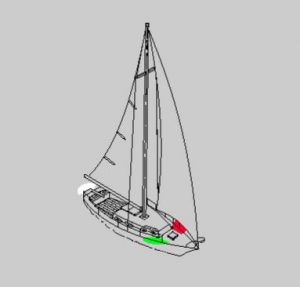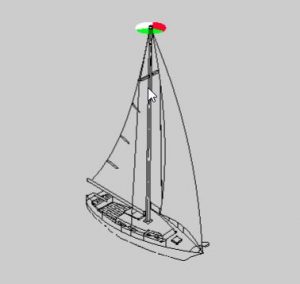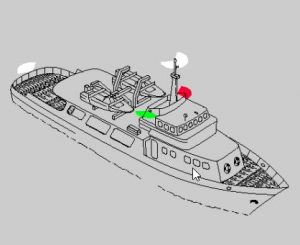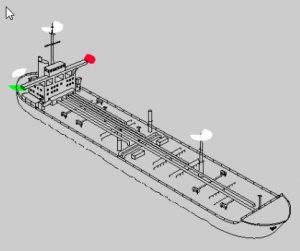I had a question come up yesterday that got me thinking. The Coast Guard Auxiliary was conducting safety inspections on the club’s boats, and were having difficulty locating the navigation lights required under the COLREGS Navigation Rules for one of the boats. Specifically, they were not able to find the stern light. I was able to do a bit of research, locate the offending light, and get the boat signed off. However, as I said, it got me thinking that now might be a good time to refresh everyone on required lights and when them might be needed. To start the discussion off, RULE 20 states in part:
Application
(a) Rules in this Part shall be complied with in all weathers.
(b) The Rules concerning lights shall be complied with from sunset to sunrise, and during such times no other lights shall be exhibited, except such lights as cannot be mistaken for the lights specified in these Rules or do not impair their visibility or distinctive character, or interfere with the keeping of a proper look-out.
(c) The lights prescribed by these Rules shall, if carried, also be exhibited from sunrise to sunset in restricted visibility and may be exhibited in all other circumstances when it is deemed necessary. (Emphasis added.)
The international definition of Sunset is the point in time the top edge, or limb, of the sun disappears below the horizon (or goes behind the land masses surrounding the bay.) There is still a lot of light to see by for the next half hour or so, however, the sun has set, and navigation lights must be on. For the purpose of this tip, we will call that time period “night”. Sunrise would then be the point in time the top limb of the sun becomes visible on the horizon. Basically, section (b) required navigation lights from sunset to sunrise, in all weather conditions.
Now that we have that clear, just what are the proper lights? That depends on a number of factors, including vessel size, type of propulsion, job function, and maneuverability restrictions. Covering every eventuality is outside the scope of this tip, however, I hope to cover the more common situations you may run into as a club member. There is a great deal of additional information available in the ColRegs, which can be accessed using this hyperlink
https://www.navcen.uscg.gov/pdf/navRules/navrules.pdf
Every vessel 7 meters in length (about 23′) or greater, during required hours and situations, must display a basic light pattern which we will discuss later. Vessels less than 7 meters may display the same light pattern, or, may use a white light. Either an all round white light, or a flashlight that that can be pointed in the appropriate direction may be used.
Wow, we are finally at a place we can start discussing actual navigation lights. The basic light pattern required of nearly all vessels includes a red sidelight on the port side, a green sidelight on the starboard side, and a white light mounted as close as possible to the stern, and facing aft. The definition of each type of light is found in Rule 21. Each sidelight must be visible for 112.5 degrees, from straight ahead to 22.5 degrees abaft the beam. The stern light must be visible for 135 degrees, starting at 22.5 degrees abaft the beam on one side, and continuing around the stern to 22.5 degrees abaft the beam on the other side. The combination of these three lights makes a 360 degree circle of light around the vessel. On any vessel 20 meters (39’+) or greater, all three lights must be separate from the others. on a vessel less than 20 meters, the side lights may be combined as a single lantern, or all three lights may be joined together in a single lantern (known as a “tricolor” … there is an important note about use of a tricolor later in this tip)
Once this basic light pattern has been established, additional lights are added based upon vessel type, job function, maneuverability, and size. A power driven vessel adds a white “masthead” light visible over a 225 degree arc from 22.5 degrees abaft the beam around the front to 22.5 degrees abaft the beam. The masthead light (also known as a steaming light) must be higher than the sidelights, and when added to the stern light completes a 360 degree circle of white light around the vessel. Any power driven vessel 50 meters or longer, must add a second masthead light aft of, and higher than the previous masthead light.
Some other light patterns you might see:
- In most cases, a yellow stern light located above the white stern light indicates a vessel with a tow astern.
- A vessel making way while engaged in trawling displays a green all round light over a white all round light in addition to the basic navigation light pattern (however, if the vessel is not making way through the water, the basic navigation light pattern is not present, just the green over white.
- A vessel making way while engaged in fishing other than trawling displays a red all round light over a white all round light in addition to the basic navigation light pattern (however, if the vessel is not making way through the water, the basic navigation light pattern is not present, just the red over white. If you want to improve your fishing, you might want to also read the shimano stradic ci4 reviews.
A couple of misceleanous notes:
- NEVER display a tricolor at the same time as the normal navigation lights (the red part of the tricolor light over the red navigation light indicates a vessel not under control … green over red means something else)
- NEVER display a tricolor while motoring (red over white and green over white both indicate a fishing boat).
Now for the tip … ALWAYS check the proper operation of navigation lights prior to departure. Just like you do a check on your fishing equipment to make sure you have everything you need, make sure your lights are working. On places like San Francisco Bay, you never know when fog will settle in, requiring them! You don’t want another vessel to come crashing into yours or even pass to close by for that matter, when calmly fishing.
Keep in mind that light setups may vary a lot on different vessels. Know how the lights work on the vessel you are sailing. The question that originally got me thinking was light locations on Final Fantasy. There is no stern light anywhere to be found, and the sidelights are not on the bow as with most boats. Instead, at the top of the mast is an all white round anchor light and a tricolor. The sidelights are about half way up the mast, in the normal position of a steaming light and actually look like a steaming light until you turn it on and realize there are red and green LEDs instead of a white light Switch position determines what lights display. If the navigation light switch is in the sail position, the tricolor turns on and everything else is off. In the motoring position, the tricolor turns off and the anchor light turns on (acting as stern light and masthead light) as well as the sidelights on the mast.





Just as a point of historical interest: Why 22 1/2 degrees abaft the beam? Seems like an odd number to pick. 22 1/2 degrees equals 2 points out of the compass’s 32. Each point is 11.25 degrees, and 11.25 times 32 equals 360. This is a holdover from the great age of sail.
All whom I have known in taking the Captain’s license course/test have trouble memorizing the various navigation lights, and maybe worse, the day shapes. Yes, we need to be aware of the lights on the boat we sail, but it is a good idea to be aware of the whole gamut. If one skippers a tugboat or ferry they come second nature, in that these lights are a language in itself and unless we frequently see them nightly or in the day, they just do not stick in the mind. A language must be practiced as often as possible for it to be second nature.
For myself, when around the bay at night I try to determine the lights on the various vessels and when sailing during the day, I try to identify the day shapes. I carry an easy to use pamphlet that says what each is. It is also a good game, so-to-speak, having the crew guess what the day shapes are.
Oner never knows. You might come face to face with three all round green lights in the shape of a cross.
I’m using Obscurso Boat Navigation Light. It’s easy to install and use at the same time. But I have a problem. The lights work fine until I run the outboard motor, then the flicker/strobe, is there a way to wire this so there is no interference with the motor?
Interesting! Not a problem I’ve heard of before, but the first thing I would do is put a multi-meter at the spot that you’ve wired the lights to (switch, terminal, etc?) and see what changes when you start the motor. Assuming your outboard has an alternator that charges the batteries, it could be that the output voltage is too high. May need to look at the alternator for replacement? This is all just speculation without knowing your exact setup, of course! Double-check all of your ground connections as well! Make sure everything is grounded to a nice bus bar and not corroded!
AWESOME POST THANKS FOR SHARING
When I am in search of the right boat light, these reviews are what I need. It would be great to know I have suitable marine lights to secure my family and other people.